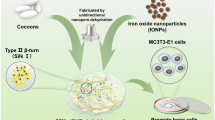Abstract
Scaffolds derived from silk fibroin are widely used as biomaterials. In this report, a new all-aqueous process is described for the production of three-dimensional porous silk fibroin scaffolds. The process uses poly(ethylene oxide), and a novel salt leaching technique. The fabricated scaffolds were tested for their physical characteristics. The measured scaffold porosity ranged from approximately 67.95% to 84.7%. Swelling studies demonstrated that the fabricated scaffolds had fair hydrophilicity. The mechanical properties of the scaffolds, namely their compressive strength and compressive modulus, were outstanding, compared to those of previous reports. Tests on the growth of cell cultures demonstrated that the scaffolds provide favorable conditions for the growth of human chondrocytes, with increases in cell attachment and cell proliferation. The use of this new technique for scaffold fabrication provides clear advantages in the field of biomaterials and related fields.

Similar content being viewed by others
References
P. X. Ma, Tissue Engineering. Encyclopedia of Polymer Science and Technology, 3rd ed., Wiley & Sons, NJ, 2004.
R. Zhang and P. X. Ma, J. Biomed. Mater. Res., 52, 430 (2000).
H. J. Kim, H. S. Kim, A. Matsumoto, I. J. Chin, H. J. Jin, and D. L. Kaplan, Aust. J. Chem., 58, 716 (2005).
R. L. Horan, K. Antle, A. L. Collette, Y. Wang, J. Huang, J. E. Moreau, V. Volloch, D. L. Kaplan, and G. H. Altman, Biomaterials, 26, 3385 (2005).
X. Zhang, C. B. Baughman, and D. L. Kaplan, Biomaterials, 29, 2217 (2008).
H. J. Jin, J. Park, R. Valluzzi, P. Cebe, and D. L. Kaplan, Biomacromolecules, 5, 711 (2004).
Y. Wang, D. D. Rudym, A. Walsh, L. Abrahamsen, H. J. Kim, H. S. Kim, C. Kirker-Head, and D. L. Kaplan, Biomaterials, 29, 3415 (2008).
H. J. Kim, U. J. Kim, G. G. Leisk, C. Bayan, I. Georgakoudi, and D. L. Kaplan, Macromol. Biosci., 7, 643 (2007).
U. J. Kim, J. Park, H. J. Kim, M. Wada, and D. L. Kaplan, Biomaterials, 26, 2775 (2005).
R. Nazarov, H. J. Jin, and D. L. Kaplan, Biomacromolecules, 5, 718 (2004).
J. Zhou, C. B. Cao, and X. L. Ma, Int. J. Biol. Macromol., 45, 504 (2009).
X. Zhang, C. Cao, X. Ma, and Y. Li, J. Mater. Sci. Mater. Med., 23, 315 (2012).
N. W. Bhat and G. S. Nadiger, J. Appl. Polym. Sci., 25, 921 (1980).
R. Y. Zhang and P. X. Ma, J. Biomed. Mater. Res., 44, 446 (1999).
R. C. Thomson, M. J. Yaszemski, J. M. Powers, and A. G. Mikos, Biomaterials, 19, 1935 (1998).
Y. Wang, E. Bella, C. S. D. Lee, C. Migliaresi, L. Pelcastre, Z. Schwarz, B. D. Boyan, and A. Motta, Biomaterials, 31, 467 (2010).
N. A. Alcantar, E. S. Aydil, and J. N. Israelachvili, J. Biomed. Mater. Res., 51, 343 (2000).
L. G. Griffith, Acta Mater., 48, 263 (2000).
L. Huang, K. Nagapudi, R. P. Apkarian, and E. L. Chaikof, J. Biomater. Sci. Polym. Ed., 12, 979 (2001).
U. J. Kim, J. Park, C. Li, H. J. Jin, R. Valluzzi, and D. L. Kaplan, Biomacromolecules, 5, 786 (2004).
T. Asakura, A. Kuzuhara, R. Tabeta, and H. Saito, Macromolecules, 18, 1841 (1985).
I. C. Um, H. Kwon, Y. H. Park, and S. Hudson, Int. J. Biol. Macromol., 29, 91 (2001).
L. D. Harris, B. S. Kim, and D. J. Mooney, J. Biomed. Mater. Res., 42, 396 (1998).
J. C. Keller, G. B. Schneider, C. M. Stanford, and B. Kellogg, Implant Dent., 12, 175 (2003).
Y. %Wang, D. J. Blasiloli, H. J. Kim, H. S. Kim, and D. L. Kaplan, Biomaterials, 27, 4434 (2006).
Author information
Authors and Affiliations
Corresponding author
Additional information
Both authors contributed equally to this article.
Rights and permissions
About this article
Cite this article
Park, H.J., Lee, J.S., Lee, O.J. et al. Fabrication of microporous three-dimensional scaffolds from silk fibroin for tissue engineering. Macromol. Res. 22, 592–599 (2014). https://doi.org/10.1007/s13233-014-2083-0
Received:
Revised:
Accepted:
Published:
Issue Date:
DOI: https://doi.org/10.1007/s13233-014-2083-0




